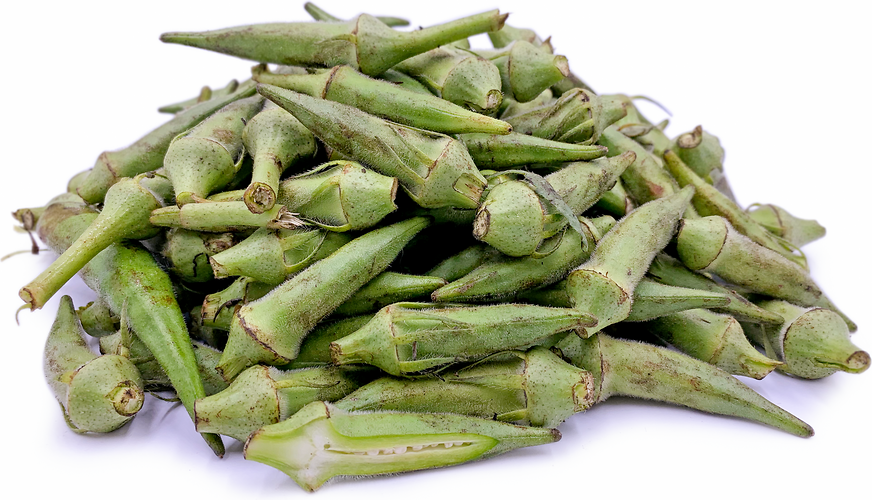


Peruvian Okra
Estimated Inventory, lb : 0
Description/Taste
Peruvian Okra is an herbaceous plant with heart-shaped leaves, thick stems, and slender, tapered pods. The green pods average 10-25 centimeters in length with firm, smooth edges, and depending on the variety, may be coated in a pale fuzz. Underneath the surface, the flesh is pale green to white, fibrous, and contains a small cavity filled with rounded seeds. When young, the seeds are white to cream-colored and as the pod matures the seeds transform into a grey, dark green hue. The flesh also contains a mucilaginous liquid that intensifies with prolonged periods of cooking. Peruvian Okra has a silky, tender, and crisp consistency when cooked, with a mild, green flavor similar to eggplant or green beans.
Seasons/Availability
Peruvian Okra is available year-round.
Current Facts
Peruvian Okra, botanically classified as Abelmoschus esculentus, are edible seed pods that grow on upright plants that can reach up to two meters in height and is a member of the Malvaceae family. Also known as Ochro, okra is one of the most heat tolerant plants that can grow in tropical and subtropical regions across the world. Though not native to Peru, okra was introduced to the country when African slaves arrived via the Atlantic slave trade and was widely adopted into native cuisine, valued for its nutritional properties and mild flavor.
Nutritional Value
Peruvian Okra is an excellent source of vitamins A, C, and K, fiber, and also contain some magnesium, potassium, calcium, and folate.
Applications
When harvested at an immature stage, Peruvian Okra can be consumed raw and tossed into salads. Though the pods can be eaten fresh, they are most popularly cooked and can be boiled, blanched, steamed, grilled, baked, and fried. Peruvian Okra has a mild flavor, and in Peru, the pods are sautéed and served with rice, stewed with tomatoes, tossed into soups and stews, stuffed, or pickled for extended use. In addition to cooking, the seeds can be roasted, ground, and used as a hot beverage and the pods can be dried and ground into a flour for use as a thickener. The leaves of the okra plant are also edible and can be lightly sautéed or braised. Peruvian Okra pairs well with meats such as poultry, chorizo, bacon, and beef, coriander, cilantro, mint, avocado, bell peppers, tomatoes, onions, garlic, plantains, potatoes, and rice. The pods should be harvested and used immediately for best flavor, but they will also keep for 2-3 days when stored in a paper bag in the refrigerator.
Ethnic/Cultural Info
Okra was introduced to Peru when the African slave trade was brought to South America in the 16th to the 17th century. As many Africans settled into working on plantations along the coastal regions of the country, they brought foods from their homeland and planted them for small scale cultivation. Over time, vegetables such as okra began to become a common element in cooking and were widely adopted into indigenous Peruvian cuisine. Okra is favored for its nutritional properties and is often prepared in one-pot meals, which was an established style of cooking in Africa that became commonplace in Peru. It is also used in ceviche, which is a famous dish of coastal Peruvian towns and is considered one of Peru’s national dishes.
Geography/History
The origins of okra are disputed, and many experts believe it is native to Africa or Asia, growing since ancient times. Peruvian Okra originally came from Africa and was introduced to the country sometime in the 16th or 17th century via the Atlantic slave trade. Today Peruvian Okra is still cultivated on a small scale in Peru and can be found at fresh local markets.
Recipe Ideas
Recipes that include Peruvian Okra. One
| Coop Can Cook |
|
Smothered Okra with Sausage & Shrimp |
| Food Fidelity |
|
Peruvian Ceviche |
| Cooktoria |
|
Easy Baked Okra |
| Que Rica Vida |
|
Rice with Okra |
| Martha Stewart |
|
Braised Lamb Shank and Okra Stew |




